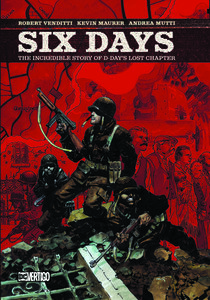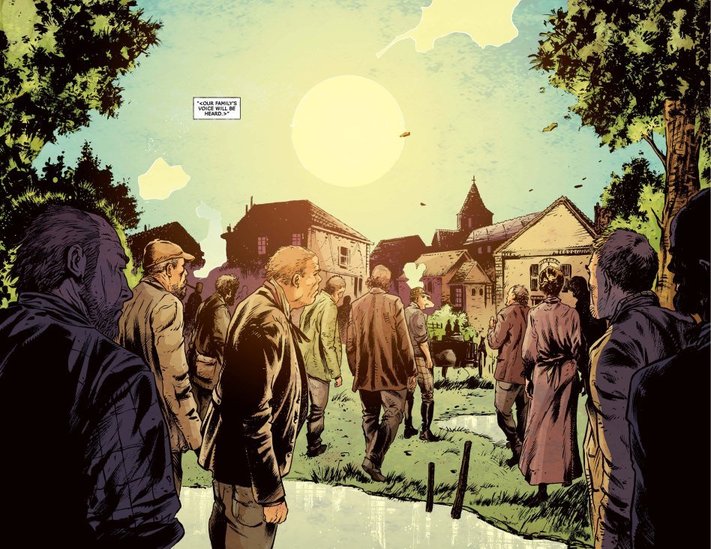Review: SIX DAYS: THE INCREDIBLE STORY OF D-DAY’S LOST CHAPTER

Writers: Robert Venditti & Kevin Maurer
Art: Andrea Mutti
Colours: Lee Loughridge
Letters: Clayton Cowles
Review by: Alex McDonald
Summary
Six Days: The Incredible Story of D-Day’s Lost Chapter is an incredibly personal tale about the village of Graignes, France during the D-Day campaign. In one of the worst mis-drops of the entire operation, a team of American soldiers found themselves isolated 15 miles southeast of the intended target. Trapped far behind enemy lines, Six Days is a story about community as well as “bravery and duty in the face of overwhelming peril” as co-writer Kevin Maurer puts it.
Whilst Maurer provides the authenticity from his nonfiction work, Robert Venditti brings the personality. “I wanted this story to be told,” he said after discovering his Uncle Tommy fought in the Battle of Graignes. Venditti discovered a letter written by one of Tommy’s war buddies that told of his bravery during the Battle of Graignes. The book features artwork from Italian Artist Andrea Mutti.
For over seventy years Venditti’s family could only assume what had happened to his Uncle Tommy. Like Venditti’s discovery of the letter, Six Days will show readers the true bravery those who fought during the Second World War, soldiers and villagers alike.

Positives
Of all the aspects that make this book great, the most obvious is the colouring. Lee Loughridge adds so much life to this already personal story. Most pages feature a single dominating colour. Green often suggests hope and prosperity in the story, with many of the happiest scenes taking place in the beautiful gardens of Graignes. Orange on the other hand is a clear indicator of danger and violence during the Six Days. Every firefight is rendered almost entirely orange as if each battle takes place in Hell itself. The distinct colours throughout offer an extra layer to the story that only the comic medium could.
Similarly to the outstanding colouring, Andrea Mutti’s artwork is beautiful. Mutti has stated that he visited Graignes and this comes across throughout the book as the village has a very strong sense of place. Even scenes in New York feel uneasy since they lack the picturesque quality of the village. Minor details also highlight Mutti’s abilities like the way he uses light sources from above during tense moments to allow soldiers’ helmets to shield their eyes in shadow, removing their humanity.
Venditti and Maurer have crafted one of the most personal war stories ever put to illustrated page. Venditti’s connection to the Six Days is heartbreaking as aspects of the real letter appear in the book. It is bittersweet as readers learn about his bravery only to mourn his loss like he was part of their family too. By highlighting the lives of the villagers just as much as the soldiers the story becomes much more relatable which again only showcases the tragedy of the Battle of Graignes even more.

Negatives
While this is a fantastic graphic novel it is not perfect. One of the main negatives from the book is that the outstanding colouring leaves certain aspects of the book unclear. To clarify, the orange firefights, while stylistically great, are all very similar. Each sequence is rendered in horrific fire but it can be hard for the reader to determine what exactly is happening until the sequence is over. This could well be a choice from the creative team as it adds to the significance of the village over the war but an argument can be made that having every firefight scene look very similar verges on boring.
Additionally the book features very few ‘army strategy’ scenes with soldiers discussing their plans. These are not bad scenes by any means but they stand out amongst the great scenes of the banality of the village facing such peril. Scenes like these feel pivotal to a war story but not necessarily significant to this story. The best pages of this book highlight the real lives of those in the village as well as how the soldiers formed a bond with said people. Disappointingly the generic army scenes can tell readers they are just reading another war comic. Thankfully there are not many of these pages in the book.

Verdict
Robert Venditti, Kevin Maurer, Lee Loughridge, Andrea Mutti and Clayton Cowles have together created something wonderful. What began as inspiration from a war letter has developed into one of the most deeply personal war stories ever told and definitely one of the best in the graphic fiction field. This is a book worth reading and all those involved in its creation deserve praise.
